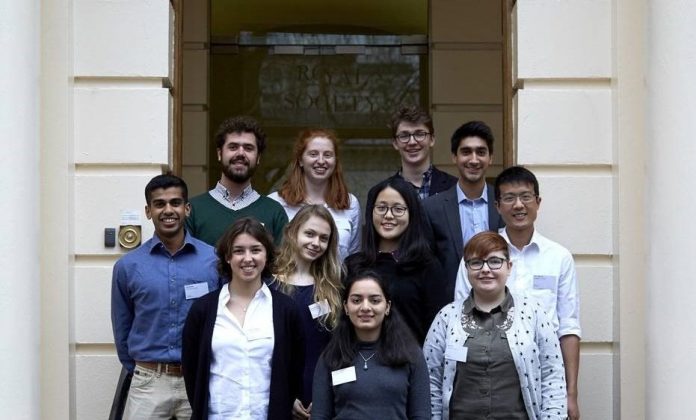“Take a look at the items on your desk: a lamp, various iDevices and a house plant. Which of these is the most advanced piece of engineering?” asks Dr Jason Kelly, CEO of the synthetic biology company Ginkgo Bioworks. He argues the case for the house plant: a self-sustaining, self-replicating and selfrenewing system. “Imagine what a self renewing iPhone would do to Apple’s profit margins!”
Biology has evolved machines of incomparable sophisitication to manmade devices, however synthetic biology, the fusion of engineering and biology affectionally known as ‘synbio’, is providing tools for scientists to exploit the genetic machinery that organisms use to live and co-opt it for novel purposes. From bacterial perfume to computing DNA, the applications are seemingly limitless, as the Oxford 2017 iGEM (International Genetically Engineered Machine Competition) team discovered when they attended a conference at the Royal Society in London.
The first speaker, Professor Christina Smolke from Stanford University, explained how her group engineered a yeast opioid production line, allowing more efficient production of the poppy-derived pain relief molecule than traditional extraction methods from its natural source. Transplanting the poppy pathway into yeast required knowledge of the protein machinery (enzymes) and genes that encode them in every stage of the natural pathway. From here, the researchers turned to other organisms to mine for alternatives. For efficiency, different stages of the pathway were segregated to different sub-compartments of the cell, much like the specialised buildings of a production factory.
Then came Dr Jason Kelly, whose Boston based company Ginkgo Bioworks is taking advantage of the falling cost of genetic engineering to expand it to new markets in the fragrance, flavour, and food industries. Their latest venture is a microbe produced version of an extinct flower’s scent. Consult Dr Kelly and his team with a product idea and they will endeavour to find a way to make a bacterial device to meet your needs. The innovation takes place in an impressive 40,000 square-foot facility, more akin to a sci-fi film set than a science lab, endowed with the latest robotics and automation. Automation is crucial to synthetic biology’s design led approach to replace time-consuming trial and error experiments. Dr Kelly’s presentation stood out in capturing the ‘blue sky’ thinking of the field, and we were excited to discover that he was part of one of the first iGEM teams.
This same approach has applications in more conventional industries while still retaining this ‘outside the box’ thinking. Dr Jeremy Shears from Shell discussed the potential of a synbio solution to the energy problem, envisioning fuel producing microbes and novel energy carriers made by photosynthesis. Many of these applications are a long way off, yet the urgency of the growing energy crisis makes advances in this field vital.
The importance of drugs derived from natural products highlighted in Professor Smolke’s presentation was revisited by Pfizer researcher Dr Edmund Graziani, who described these chemicals as “privileged” because they have been fine-tuned by evolution. However, he explained that in the past only a subset of these chemicals were suitable to be developed into drugs because they had to be small enough to enable them to be properly processed by the body. Not only did this limit the compounds that could be developed, but also left many diseases “undruggable”. Dr Graziani argues the case for creating a microbial machine that can perform “directed evolution”: the bacteria would take existing natural products, modify them, and spew out only the most promising potential drugs. To realise this approach, however many technical hurdles must be overcome.
A recent addition to the synbio toolkit, the development of techniques to incorporate unnatural amino acid building blocks into proteins in vivo is proving useful in pharmaceuticals and beyond. Usually cells are limited to using only 20 of these building blocks, so expanding this repertoire by adding phantom amino acids could greatly enhance diversity. What’s more, the scientists can choose the precise site into which to introduce the unnatural amino acids to specifically decorate the protein with chemical labels. These are useful, for example, in making the protein visible under a microscope or in allowing it to be attached to a drug delivery vehicle.
The final speaker, Microsoft’s Dr Andrew Phillips, presented research into “bio-computing”, explaining how knowledge of how cells compute is being exploited to programme DNA and organisms. For example, the “consensus algorithm”, which causes participants to agree to do the same thing, was ‘invented’ and utilised by cells as a means of controlling cell division. There are exciting advances here, but it seems that at the moment the biology is more complicated than the computer science: biology is more unpredictable and noisy than electronics so we must be careful not to overstretch the analogy of “genes as circuits”.
I took a lot away from the diversity of the talks, not only inspiration for iGEM but also a better understanding of the current achievements, future promises, and limitations of the field of synthetic biology. The scope of synbio applications we learnt from the conference certainly hasn’t helped us narrow down ideas for our own project, but we left excited by the fact that we may be able to contribute to this rapidly-expanding area of biology.
For Cherwell, maintaining editorial independence is vital. We are run entirely by and for students. To ensure independence, we receive no funding from the University and are reliant on obtaining other income, such as advertisements. Due to the current global situation, such sources are being limited significantly and we anticipate a tough time ahead – for us and fellow student journalists across the country.
So, if you can, please consider donating. We really appreciate any support you’re able to provide; it’ll all go towards helping with our running costs. Even if you can't support us monetarily, please consider sharing articles with friends, families, colleagues - it all helps!
Thank you!



